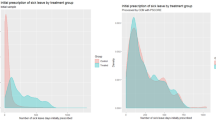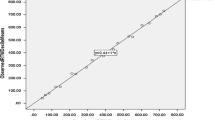Abstract
The purpose of this study was to determine factors related to a return to work following the completion of a work hardening program. Data from the Workers' Compensation Board of Alberta Millard Rehabilitation Centre for 1527 discharges, collected over 22 months, were examined retrospectively. Factors related to return to work were compared bivariately using logistic regression procedures. A multiple logistic regression model for return to work was also determined. The principle predictor of return to work was job-attached status to the pre-injury employer. Other factors related to return to work were education, primary diagnosis, injury to admission time, job attachment to the pre-accident employer, employer's annual payroll, and vocational direction. Due to the strength of the association between job-attached status to the pre-injury employer and a return to work, it was concluded that attempts to maintain this relationship should be a priority for rehabilitation providers and insurance carriers.
Similar content being viewed by others
References
Human Resources Development Canada.Occupational injuries and their cost in Canada 1988–1992. Ottawa: HRDC, 1993.
Commission on Accreditation of Rehabilitation Facilities.Standards manual and interpretive guidelines for organizations serving people with disabilities. Tucson: CARF, 1994.
Graly JM, Yi S, Jensen GM, Gibson M, Laborde T. Factors influencing return to work for clients in a work-hardening center.Work 1994; 4: 9–21.
Moffroid MT, Aja D, Haugh LD, Henry S. Efficacy of a part-time work hardening program for persons with low-back pain.Work 1993; 3: 14–20.
Flinn-Wagner S, Mladonicky A, Goodman G. Characteristics of workers with upper extremity injuries who make a successful transition to work.J Hand Ther 1990; 3: 51–55.
Wilson S, Haws C, Naccarato P, Beaulne AP. Functional activities versus work hardening in the rehabilitation of the injured worker.Work 1994; 4: 264–269.
Niemeyer LO, Jabobs K, Reynolds-Lynch K, Bettencourt C, Lang S. Work hardening: Past, present, and future—the work programs special interest section national work-hardening outcome study.Am J Occup Ther 1994; 48: 327–339.
Edwards BC, Zusman M, Hardcastle P, Twomey L, O'Sullivan P, McLean N. A physical approach to the rehabilitation of patients disabled by chronic low back pain.Med J Aust 1992; 156: 167–172.
Ambrosius FM, Rounds BK, Herkner PB, Dekraker MA, Bartz SR. Reactivation of injured workers involved in a work-hardening program.Work 1994; 4: 28–34.
SPSS Inc.Advanced statistics student guide. Chicago: SPSS, 1990.
Johnson WG, Ondrich J. The duration of post-injury absences from work.Rev Economics Stat 1990; 72: 714–724.
Ruser JW. Workers' compensation and occupational injuries and illnesses.J Labor Economics 1991; 9: 325–350.
Tate DG. Workers' disability and return to work.Am J Phys Med Rehabil 1992; 71: 92–96.
Wyman ET, Cats-Baril WL. Working it out: Recommendations from a multidisciplinary national consensus panel on medical problems in workers' compensation.J Occup Med 1994; 36: 144–154.
Cheadle A, Franklin G, Wolfhagen C,et al. Factors influencing the duration of work-related disability: A population-based study of Washington state workers' compensation.Am J Public Health 1994; 84: 190–196.
Cornes P. The vocational rehabilitation index: A guide to accident victims' requirements for return-to-work assistance.Int Disabil Studies 1990; 12: 32–36.
Drury D. Disability management in small firms.Rehab Counseling Bull 1991; 34: 243–256.
Kemmlert K, Lundholm L. Factors influencing egonomic conditions and employment rate after an occupational musculoskeletal injury.J Occup Rehab 1994; 4: 11–21.
Lancourt J, Kettelhut M. Predicting return to work for lower back pain patients receiving worker's compensation.Spine 1992; 17: 629–640.
Madill HM, Montgomerie C, Brintnell ES, Stewin LL. From private to public-sector employment—longitudinal follow-up on roles and values of a cohort group.Work 1994; 4: 103–113.
Peters P. Successful return to work following a musculoskeletal injury.AAOHN J 1990; 38: 264–270.
Burgel BJ, Glinieki CM. Disability behavior: delayed recovery in employees with work compensable injuries. AAOHN J 1986; 34: 26–30.
Eaton MW. Obstacles to the vocational rehabilitation of individuals receiving workers' compensation.J Rehab 1979; 45: 59–63.
Roessler RT. Motivational factors influencing return to work.J Appl Rehab Counsel 1989; 20: 14–17
Hazard RG, Fenwick JW, Kalisch SM. Functional restoration with behavioral support: A one-year perspective study of patients with chronic low-back pain.Spine 1989; 14: 157–161.
Kohles S, Barnes D, Gatchel RJ, Mayer TG. Improved physical performance outcomes after functional restoration treatment in patients with chronic low-back pain: Early versus recent training results.Spine 1990; 15: 1321–1324.
Feuerstein M. A multidisciplinary approach to the prevention, evaluation and management of work disability.J Occup Rehab 1991; 1: 5–12.
Carosella AM, Lackner JM, Feuerstein M. Factors associated with early discharge from a multidisciplinary work rehabilitation program for chronic low back pain.Pain 1994; 57: 69–76.
Fredrickson BE, Trief PM, VanBeverson P, Yuan HA, Baum G. Rehabilitation of the patient with chronic back pain: A search for outcome predictors.Spine 1988; 13: 351–353.
Milhous RL, Haugh LD, Frymoyer JW, Ruess JM, Gallagher RM, Wilder DG, Callas PW. Determinants of vocational disability in patients with low back pain.Arch Phys Med Rehabil 1989; 70: 589–593.
Author information
Authors and Affiliations
Rights and permissions
About this article
Cite this article
Voaklander, D.C., Beaulne, A.P. & Lessard, R.A. Factors related to outcome following a work hardening program. J Occup Rehab 5, 71–85 (1995). https://doi.org/10.1007/BF02109911
Issue Date:
DOI: https://doi.org/10.1007/BF02109911




